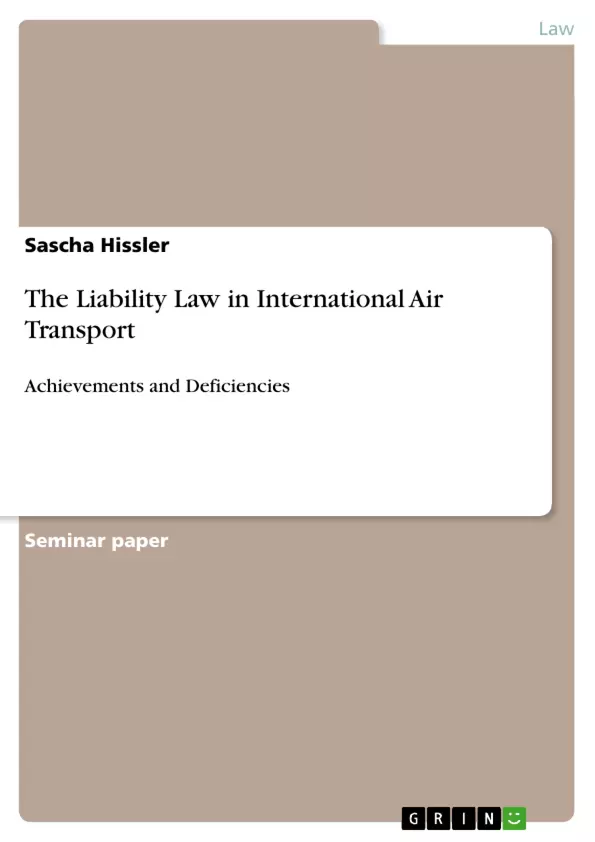Law in general is subdivided in two parts: in public law and in private law. Public law governs the relationship between individuals and the states whereas private law regulates the relationship between individuals.
When it comes to the laws ruling the aviation world, we also have to divide into these two parts: the public international air law represented in general by the Chicago Convention (formally „The Convention on International Civil Aviation“ done at Chicago on 7 December 1944) and on the other side the private international air law, mainly represented through the Montreal Convention (formally „Convention for the Unification of Certain Rules for the International Carriage by Air“). The latter represents the liability law in international air transport, regulating the relationship between an air carrier and its customer, passenger, consignor or cargo shipper. It is supposed to replace the Warsaw Convention of 1929 which sets compensation levels for victims of air accidents,
as well as liability for damage, delay or loss of baggage and cargo.
This paper describes first the historical way the Convention developed from Warsaw to Montreal and then goes into detail of the Montreal Convention with its achievements and deficiencies. By quoting from the original, it is written very close to the wording of the Convention, emphasizing the parallels and differences of the Warsaw and the Montreal Convention.
Structuring:
Abbreviations
Introduction
History
The Warsaw System
The Montreal Convention 1999
Achievements
Deficiencies
Conclusion
Literature
Internet-Sources
Inhaltsverzeichnis (Table of Contents)
- Abbreviations
- Introduction
- History
- The Warsaw System
- Protocol to Amend the Convention for the Unification of Certain Rules Relating to International Carriage by Air
- Convention Supplementary to the Warsaw Convention for the Unification of Certain Rules Relating to International Carriage by Air Performed by a Person other than the Contracting Carrier
- The Guatemala Protocol
- The Montreal Convention 1999
- Achievements
- Deficiencies
- Conclusion
- Literature
- Internet-Sources
Zielsetzung und Themenschwerpunkte (Objectives and Key Themes)
This paper provides an overview of the legal framework governing international air carriage, with a specific focus on the liability law. It examines the historical development of the Warsaw System and the Montreal Convention 1999, analyzing their achievements and shortcomings. The paper primarily focuses on the evolution of liability rules in international air transport, emphasizing the parallels and differences between the Warsaw and Montreal Conventions.
- Historical development of international air carriage liability law
- Comparison of the Warsaw and Montreal Conventions
- Analysis of the Montreal Convention's achievements
- Assessment of the Montreal Convention's deficiencies
- Impact of the Montreal Convention on passenger, baggage, and cargo transport
Zusammenfassung der Kapitel (Chapter Summaries)
This section will provide summaries of the main chapters of the text, excluding the conclusion and any chapters containing major revelations or spoilers.
- Abbreviations: This chapter provides a list of abbreviations used throughout the paper, defining terms like CC (Chicago Convention), EU (European Union), IATA (International Air Transport Association), and others.
- Introduction: This chapter introduces the topic of international air carriage law and its division into public and private law. It emphasizes the importance of the Montreal Convention in regulating the relationship between air carriers and their customers, replacing the Warsaw Convention in setting compensation levels and liability for damages, delays, and losses.
- History: This chapter delves into the historical evolution of the legal framework governing international air carriage. It introduces the Warsaw System, a set of rules and regulations established by the Warsaw Convention of 1929. The chapter highlights the Warsaw Convention's key objectives, such as establishing the principle of air carriers' liability for damages caused to passengers, baggage, and goods, as well as for delays. It further explains the Warsaw Convention's importance in providing a degree of uniformity to passengers boarding aircraft worldwide.
- The Warsaw System: This chapter examines the various amendments, conventions, and protocols that expanded the Warsaw System. It focuses on three significant additions: The Hague Protocol of 1955, the Guadalajara Convention of 1961, and the Guatemala Protocol of 1971. Each addition addressed specific aspects of international air carriage, such as increased liability limits, chartering regulations, and liability for damage caused by negligence.
Schlüsselwörter (Keywords)
Key terms and concepts central to this work include: international air carriage, liability law, Warsaw Convention, Montreal Convention, passenger rights, baggage, cargo, compensation, damage, delay, negligence, air carrier, aviation law, international civil aviation, legal framework, historical development, achievements, deficiencies, uniformity.
- Citation du texte
- Diplom-Staatswissenschaftler (univ.) Sascha Hissler (Auteur), 2009, The Liability Law in International Air Transport, Munich, GRIN Verlag, https://www.grin.com/document/132887



